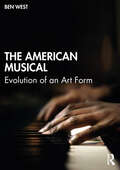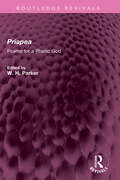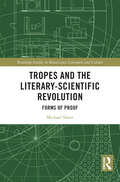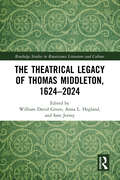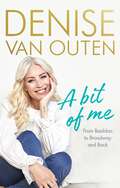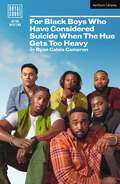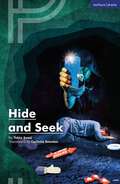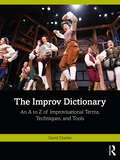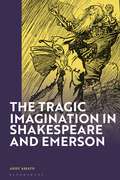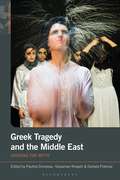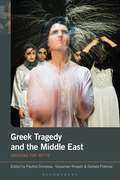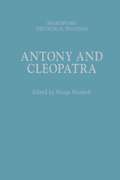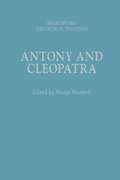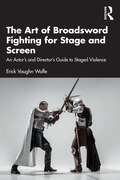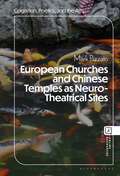- Table View
- List View
The American Musical: Evolution of an Art Form
by Ben WestThe American Musical is a comprehensive history of an American art form. It delivers a detailed and definitive portrait of the American musical’s artistic evolution over the course of seven distinct, newly defined eras, with a unique perspective gleaned from research at more than twenty different archives across the United States.Individual in both its approach and coverage, The American Musical traces the form’s creative journey from its 19th century beginnings, through its 20th century maturation, and to the turn of the 21st century, shedding new light on a myriad of authors, directors, and craftspeople who worked on Broadway and beyond. This book actively addresses the form’s often overlooked female and African-American artists, provides an in-depth accounting of such outside influences as minstrelsy, vaudeville, nightclubs, and burlesque, and explores the dynamic relationship between the form and the consciousness of its country.The American Musical is a fascinating and insightful read for students, artists, and afficionados of the American musical, and anyone with an interest in this singular form of entertainment.
The American Musical: Evolution of an Art Form
by Ben WestThe American Musical is a comprehensive history of an American art form. It delivers a detailed and definitive portrait of the American musical’s artistic evolution over the course of seven distinct, newly defined eras, with a unique perspective gleaned from research at more than twenty different archives across the United States.Individual in both its approach and coverage, The American Musical traces the form’s creative journey from its 19th century beginnings, through its 20th century maturation, and to the turn of the 21st century, shedding new light on a myriad of authors, directors, and craftspeople who worked on Broadway and beyond. This book actively addresses the form’s often overlooked female and African-American artists, provides an in-depth accounting of such outside influences as minstrelsy, vaudeville, nightclubs, and burlesque, and explores the dynamic relationship between the form and the consciousness of its country.The American Musical is a fascinating and insightful read for students, artists, and afficionados of the American musical, and anyone with an interest in this singular form of entertainment.
Priapea: Poems for a Phallic God (Routledge Revivals)
by W. H. ParkerFirst published in 1988, Priapea is a collection of eighty Latin epigrams, English translated, that make up the corpus Priapeorum, which displays remarkable skill, artistry and wit. Their elegance of style contrasts strikingly with their indecent subject matter. The poems are mostly spoken by, or addressed to, the lewd god Priapus, famous for the size and tenseness of his erect membrum virile or phallus. A main theme is the threatened use of his formidable organ to assault obscenely any intruders that he may catch thieving, but requests and offsprings made to Priapus, and his comparison of himself with other deities, also figure prominently among the poems. This book will be of interest of literature, classical studies, and translation studies.
Priapea: Poems for a Phallic God (Routledge Revivals)
First published in 1988, Priapea is a collection of eighty Latin epigrams, English translated, that make up the corpus Priapeorum, which displays remarkable skill, artistry and wit. Their elegance of style contrasts strikingly with their indecent subject matter. The poems are mostly spoken by, or addressed to, the lewd god Priapus, famous for the size and tenseness of his erect membrum virile or phallus. A main theme is the threatened use of his formidable organ to assault obscenely any intruders that he may catch thieving, but requests and offsprings made to Priapus, and his comparison of himself with other deities, also figure prominently among the poems. This book will be of interest of literature, classical studies, and translation studies.
Tropes and the Literary-Scientific Revolution: Forms of Proof (Routledge Studies in Renaissance Literature and Culture)
by Michael SlaterTropes and the Literary-Scientific Revolution: Forms of Proof argues that the rise of mechanical science in the seventeenth century had a profound impact on both language and literature. To the extent that new ideas about things were accompanied by new attitudes toward words, what we commonly regard as the “scientific revolution” inevitably bore literary dimensions as well. Literary tropes and forms underwent tremendous reassessment in the seventeenth century, and early modern science was shaped just as powerfully by contest over the place of literary figures, from personification and metaphor to anamorphosis and allegory. In their rejection of teleological explanations of natural motion, for instance, early modern philosophers often disputed the value of personification, a figural projection of interiority onto what was becoming increasingly a mechanical world. And allegory—a dominant mode of literature from the late Middle Ages until well into the Renaissance—became “the vice of those times,” as Thomas Rymer described it in 1674. This book shows that its acute devaluation was possible only in conjunction with a distinctively modern physics. Analyzing writings by Sidney, Shakespeare, Bacon, Jonson, Brahe, Kepler, Galileo, Hobbes, Descartes, and more, it asserts that the scientific revolution was a literary phenomenon, just as the literary revolution was also a scientific one.
Tropes and the Literary-Scientific Revolution: Forms of Proof (Routledge Studies in Renaissance Literature and Culture)
by Michael SlaterTropes and the Literary-Scientific Revolution: Forms of Proof argues that the rise of mechanical science in the seventeenth century had a profound impact on both language and literature. To the extent that new ideas about things were accompanied by new attitudes toward words, what we commonly regard as the “scientific revolution” inevitably bore literary dimensions as well. Literary tropes and forms underwent tremendous reassessment in the seventeenth century, and early modern science was shaped just as powerfully by contest over the place of literary figures, from personification and metaphor to anamorphosis and allegory. In their rejection of teleological explanations of natural motion, for instance, early modern philosophers often disputed the value of personification, a figural projection of interiority onto what was becoming increasingly a mechanical world. And allegory—a dominant mode of literature from the late Middle Ages until well into the Renaissance—became “the vice of those times,” as Thomas Rymer described it in 1674. This book shows that its acute devaluation was possible only in conjunction with a distinctively modern physics. Analyzing writings by Sidney, Shakespeare, Bacon, Jonson, Brahe, Kepler, Galileo, Hobbes, Descartes, and more, it asserts that the scientific revolution was a literary phenomenon, just as the literary revolution was also a scientific one.
The Theatrical Legacy of Thomas Middleton, 1624–2024 (Routledge Studies in Renaissance Literature and Culture)
This volume celebrates Thomas Middleton’s legacy as a dramatist, marking the 400th anniversary of Middleton’s final and most contentious work for the public theatres, A Game at Chess (1624).The collection is divided into three sections: ‘Critical and Textual Reception’, ‘Afterlives and Legacies’, and ‘Practice and Performance’. This division reflects the book’s holistic approach to Middleton’s canon, and its emphasis on the continuing significance of Middleton’s writing to the study of early modern English drama. Each section offers an assessment of the place of Middleton’s drama in culture, criticism, and education today through a range of critical approaches.Featuring work from a range of voices (from early career, independent, and seasoned academics and practitioners), the collection will be appropriate for both specialists in early modern literature and drama who are interested in both theory and practice, and students or scholars researching Middleton’s historical significance to the study of early theatre.
The Theatrical Legacy of Thomas Middleton, 1624–2024 (Routledge Studies in Renaissance Literature and Culture)
by William David Green Anna L. Hegland Sam JermyThis volume celebrates Thomas Middleton’s legacy as a dramatist, marking the 400th anniversary of Middleton’s final and most contentious work for the public theatres, A Game at Chess (1624).The collection is divided into three sections: ‘Critical and Textual Reception’, ‘Afterlives and Legacies’, and ‘Practice and Performance’. This division reflects the book’s holistic approach to Middleton’s canon, and its emphasis on the continuing significance of Middleton’s writing to the study of early modern English drama. Each section offers an assessment of the place of Middleton’s drama in culture, criticism, and education today through a range of critical approaches.Featuring work from a range of voices (from early career, independent, and seasoned academics and practitioners), the collection will be appropriate for both specialists in early modern literature and drama who are interested in both theory and practice, and students or scholars researching Middleton’s historical significance to the study of early theatre.
A Bit of Me: From Basildon to Broadway, and back
by Denise Van OutenDenise Van Outen, original 90s 'ladette', West End star and primetime TV favourite, reveals for the first time the true story of grit and graft beneath the famous Essex sparkle.In this refreshingly candid memoir, Denise speaks openly and sensitively about her rollercoaster career, her struggles in a past high-profile relationship and the betrayal she suffered at the hands of those once closest to her, with the hope that in doing so, she can help empower others to avoid and overcome any similar difficulties they may face.Denise shot to fame on The Big Breakfast in her early twenties. After a decade grafting through theatre jobs and children's TV shows, she was finally living the dream. However her life soon turned into a nightmare off-screen and behind the headlines as her heart was broken in a very public relationship, whilst her every move was printed in the tabloids thanks to her phone being tapped. After receiving a panning by the critics for her late night TV show aimed at the post-pub crowd, she then auditioned for and accepted an offer to play Roxie Hart in Chicago, which turned out to be a life-changing experience. The role took her to Broadway, where she caught the eye of one Andrew Lloyd Webber, eventually landing a judging role on Any Dream Will Do, which saw her rise back to primetime and the career that she loves, where she has stayed and flourished. Now, in her first memoir, Denise tells her story with disarming candour, unafraid to reveal vulnerabilities beneath the cheerful exterior. Tackling difficult subjects of corrosive self-doubt, betrayal, invasions of privacy and professional struggles, interjected with the familiar humour that we all know and love, A Bit of Me is personal, at times raw, often mischievous and always compelling. Denise has lived the life, learned the lessons, and Basildon to Broadway and back is a hell of a journey.
For Black Boys Who Have Considered Suicide When The Hue Gets Too Heavy (Modern Plays)
by Ryan Calais CameronNominated for Best New Play at the 2023 Olivier AwardsI found a king in me and now I love youI found a king in you and now I love meFather figures and fashion tips. Lost loves and jollof rice. African empires and illicit sex. Good days and bad days. Six young Black men meet for group therapy, and let their hearts - and imaginations - run wild.Inspired by Ntozake Shange's essential work For Colored Girls Who Have Considered Suicide / When the Rainbow is Enuf, For Black Boys Who Have Considered Suicide When The Hue Gets Too Heavy is a profound and playful work, co-commissioned by Boundless Theatre, from multi-award-winning company Nouveau Riche and playwright Ryan Calais Cameron.For Black Boys... gained critical acclaim for the world premiere in October 2021 at New Diorama Theatre, before successfully transferring to London's Royal Court Theatre in March 2022. This edition was published to coincide with the second West End production at the Garrick Theatre in March 2024.
For Black Boys Who Have Considered Suicide When The Hue Gets Too Heavy (Modern Plays)
by Ryan Calais CameronNominated for Best New Play at the 2023 Olivier AwardsI found a king in me and now I love youI found a king in you and now I love meFather figures and fashion tips. Lost loves and jollof rice. African empires and illicit sex. Good days and bad days. Six young Black men meet for group therapy, and let their hearts - and imaginations - run wild.Inspired by Ntozake Shange's essential work For Colored Girls Who Have Considered Suicide / When the Rainbow is Enuf, For Black Boys Who Have Considered Suicide When The Hue Gets Too Heavy is a profound and playful work, co-commissioned by Boundless Theatre, from multi-award-winning company Nouveau Riche and playwright Ryan Calais Cameron.For Black Boys... gained critical acclaim for the world premiere in October 2021 at New Diorama Theatre, before successfully transferring to London's Royal Court Theatre in March 2022. This edition was published to coincide with the second West End production at the Garrick Theatre in March 2024.
Hide and Seek (Modern Plays)
by Tobia RossiIt's nice to have a secret.Gio, who has never felt accepted by anyone - not by parents, teachers or peers - decides to disappear and hide out in a secluded cave. When his popular classmate Mirko discovers him, Gio enlists him as an accomplice, convincing him to preserve his secret despite the media frenzy over his disappearance. The boys embark on an unexpected journey towards self-discovery and acceptance, setting in motion a series of dramatic consequences. The play shines a light on bullying, homophobia and the power of social media, exploring how discriminatory voices can deeply impact young minds. It highlights how being yourself is still a risky proposition in our society when it comes to sexual orientation and independent thought. Tobia Rossi's Hide and Seek is a moving and darkly entertaining play that pits two teenage boys against each other in the face of the contagious prejudice of their small Italian town. This edition was published to coincide with the production at London's Park Theatre in March 2024.
Hide and Seek (Modern Plays)
by Tobia RossiIt's nice to have a secret.Gio, who has never felt accepted by anyone - not by parents, teachers or peers - decides to disappear and hide out in a secluded cave. When his popular classmate Mirko discovers him, Gio enlists him as an accomplice, convincing him to preserve his secret despite the media frenzy over his disappearance. The boys embark on an unexpected journey towards self-discovery and acceptance, setting in motion a series of dramatic consequences. The play shines a light on bullying, homophobia and the power of social media, exploring how discriminatory voices can deeply impact young minds. It highlights how being yourself is still a risky proposition in our society when it comes to sexual orientation and independent thought. Tobia Rossi's Hide and Seek is a moving and darkly entertaining play that pits two teenage boys against each other in the face of the contagious prejudice of their small Italian town. This edition was published to coincide with the production at London's Park Theatre in March 2024.
The Theban Plays (Penguin Classics): (pdf)
by Sophocles E. F. Watling (Translator Introduction‘O Light! May I never look on you again, Revealed as I am, sinful in my begetting, Sinful in marriage, sinful in shedding of blood!’ The legends surrounding the royal house of Thebes inspired Sophocles (496–406 BC) to create a powerful trilogy of mankind’s struggle against fate. King Oedipus tells of a man who brings pestilence to Thebes for crimes he does not realise he has committed, and then inflicts a brutal punishment upon himself. With profound insights into the human condition, it is a devastating portrayal of a ruler brought down by his own oath. Oedipus at Colonus provides a fitting conclusion to the life of the aged and blinded king, while Antigone depicts the fall of the next generation, through the conflict between a young woman ruled by her conscience and a king too confident in his own authority. E. F. Watling’s masterful translation is accompanied by an introduction, which examines the central themes of the plays, the role of the Chorus, and the traditions and staging of Greek tragedy. For more than seventy years, Penguin has been the leading publisher of classic literature in the English-speaking world. With more than 1,700 titles, Penguin Classics represents a global bookshelf of the best works throughout history and across genres and disciplines. Readers trust the series to provide authoritative texts enhanced by introductions and notes by distinguished scholars and contemporary authors, as well as up-to-date translations by award-winning translators.
The Improv Dictionary: An A to Z of Improvisational Terms, Techniques, and Tools
by David CharlesThe Improv Dictionary: An A to Z of Improvisational Terms, Techniques, and Tools explores improvisational approaches and concepts drawn from a multitude of movements and schools of thought to enhance spontaneous and collaborative creativity.This accessible resource reveals and interrogates the inherited wisdoms contained in the very words we use to describe modern improv. Each detailed definition goes beyond the obvious clichés and seeks a nuanced and inclusive understanding of how art of the moment can be much more than easy laughs and cheap gags (even when it is being delightfully irreverent and wildly funny). This encyclopedic work pulls from a wide array of practitioners and practices, finding tensions and commonalities from styles as diverse as Theatresports, Comedysportz, the Harold, narrative long-form, Playback Theatre, and Boal’s Theatre of the Oppressed. Entries include nuanced definitions, helpful examples, detailed explorations of the concepts in practice, and framing quotes from a leading practitioner or inspirational artistic voice.The Improv Dictionary offers valuable insights to novice improvisers taking their first steps in the craft, seasoned performers seeking to unlock the next level of abandon, instructors craving a new comprehensive resource, and scholars working in one of the numerous allied fields that find enrichment through collaborative and guided play.Each significant entry in the book is also keyed to an accompanying improv game or exercise housed at www.improvdr.com, enabling readers to dig deeper into their process.
The Improv Dictionary: An A to Z of Improvisational Terms, Techniques, and Tools
by David CharlesThe Improv Dictionary: An A to Z of Improvisational Terms, Techniques, and Tools explores improvisational approaches and concepts drawn from a multitude of movements and schools of thought to enhance spontaneous and collaborative creativity.This accessible resource reveals and interrogates the inherited wisdoms contained in the very words we use to describe modern improv. Each detailed definition goes beyond the obvious clichés and seeks a nuanced and inclusive understanding of how art of the moment can be much more than easy laughs and cheap gags (even when it is being delightfully irreverent and wildly funny). This encyclopedic work pulls from a wide array of practitioners and practices, finding tensions and commonalities from styles as diverse as Theatresports, Comedysportz, the Harold, narrative long-form, Playback Theatre, and Boal’s Theatre of the Oppressed. Entries include nuanced definitions, helpful examples, detailed explorations of the concepts in practice, and framing quotes from a leading practitioner or inspirational artistic voice.The Improv Dictionary offers valuable insights to novice improvisers taking their first steps in the craft, seasoned performers seeking to unlock the next level of abandon, instructors craving a new comprehensive resource, and scholars working in one of the numerous allied fields that find enrichment through collaborative and guided play.Each significant entry in the book is also keyed to an accompanying improv game or exercise housed at www.improvdr.com, enabling readers to dig deeper into their process.
The Tragic Imagination in Shakespeare and Emerson
by Andy AmatoWhat is the “tragic imagination”? And what role does it play in the works of William Shakespeare and Ralph Waldo Emerson? Explaining the tragic imagination as a creative faculty employed to answer the perennial Riddle of the Sphinx – a theory of the world that advances human freedom and dignity in the face of historical injustice, cruelty and violence – Andy Amato seeks to recover and rehabilitate this concept by revealing its significance to both key works of philosophy and literature and our contemporary world. This book begins with a close and careful reading of Emerson's first major work, Nature, in conversation with nineteenth and 20thcentury continental philosophy, critical theory and post-structuralism. Uncovering neglected elements of Emerson's philosophy, beyond his reputation as the philosopher of 'cheer', this book explores how Emersonian transcendentalism affirms rather than denies the tragic sense of life – “tragic idealism” – and makes a substantial contribution to philosophy's perpetual endeavour to solve the Riddle. In the second part of the book, Amato then employs Emerson's theoretical lens to interpret Shakespeare's tragedy, King Lear. In doing so, he innovatively reframes the central themes of suffering, vision, nature, nothing, foolishness and silence toward achieving liberation.By pairing these two giants of literature and philosophy, The Tragic Imagination in Shakespeare and Emerson not only offers fresh interpretations of Nature and King Lear, but also makes the case for the renewed deployment of tragic imagination, in creative redress, to our current social-political situation.
The Tragic Imagination in Shakespeare and Emerson
by Andy AmatoWhat is the “tragic imagination”? And what role does it play in the works of William Shakespeare and Ralph Waldo Emerson? Explaining the tragic imagination as a creative faculty employed to answer the perennial Riddle of the Sphinx – a theory of the world that advances human freedom and dignity in the face of historical injustice, cruelty and violence – Andy Amato seeks to recover and rehabilitate this concept by revealing its significance to both key works of philosophy and literature and our contemporary world. This book begins with a close and careful reading of Emerson's first major work, Nature, in conversation with nineteenth and 20thcentury continental philosophy, critical theory and post-structuralism. Uncovering neglected elements of Emerson's philosophy, beyond his reputation as the philosopher of 'cheer', this book explores how Emersonian transcendentalism affirms rather than denies the tragic sense of life – “tragic idealism” – and makes a substantial contribution to philosophy's perpetual endeavour to solve the Riddle. In the second part of the book, Amato then employs Emerson's theoretical lens to interpret Shakespeare's tragedy, King Lear. In doing so, he innovatively reframes the central themes of suffering, vision, nature, nothing, foolishness and silence toward achieving liberation.By pairing these two giants of literature and philosophy, The Tragic Imagination in Shakespeare and Emerson not only offers fresh interpretations of Nature and King Lear, but also makes the case for the renewed deployment of tragic imagination, in creative redress, to our current social-political situation.
Greek Tragedy and the Middle East: Chasing the Myth (Classical Diaspora)
by Pauline Donizeau, Yassaman Khajehi and Daniela PotenzaEmploying the idea of interculturality to study Middle Eastern adaptations of Greek tragedy from the turn of 20th century until the present day, this book first explores the earlier phase of the development of Greek classical reception in Middle Eastern theatre. It then moves to focus on modern Arabic, Persian and Turkish adaptations of Greek tragedy both in the early post-colonial and contemporary periods in the MENA and in Europe. Case by case, this book examines how the classical sources are reworked and adapted, as well as how they engage with interculturality, hybridisation and the circulation of aesthetics and models. At the same time, it explores the implications and consequences of expressing socio-political concerns through classical Greek sources. While Muslim thinkers and translators introduced Greek philosophy – in particular Aristotle's Poetics – to the West in the Middle Ages, adaptations of Greek tragedies only appeared in the MENA region at the very beginning of the 20th century. For this reason, the development of Greek tragedy in the Middle East is difficult to disentangle from colonialism and cultural imperialism. Encompassing language differences and offering for the first time a broad approach on the Middle-Eastern reception of Greek tragedy, this book produces a renewed focus on a fascinating aspect of the classical tradition.
Greek Tragedy and the Middle East: Chasing the Myth (Classical Diaspora)
Employing the idea of interculturality to study Middle Eastern adaptations of Greek tragedy from the turn of 20th century until the present day, this book first explores the earlier phase of the development of Greek classical reception in Middle Eastern theatre. It then moves to focus on modern Arabic, Persian and Turkish adaptations of Greek tragedy both in the early post-colonial and contemporary periods in the MENA and in Europe. Case by case, this book examines how the classical sources are reworked and adapted, as well as how they engage with interculturality, hybridisation and the circulation of aesthetics and models. At the same time, it explores the implications and consequences of expressing socio-political concerns through classical Greek sources. While Muslim thinkers and translators introduced Greek philosophy – in particular Aristotle's Poetics – to the West in the Middle Ages, adaptations of Greek tragedies only appeared in the MENA region at the very beginning of the 20th century. For this reason, the development of Greek tragedy in the Middle East is difficult to disentangle from colonialism and cultural imperialism. Encompassing language differences and offering for the first time a broad approach on the Middle-Eastern reception of Greek tragedy, this book produces a renewed focus on a fascinating aspect of the classical tradition.
Antony and Cleopatra: Shakespeare: The Critical Tradition (Shakespeare: The Critical Tradition)
by Joseph Candido Professor Brian VickersThis new volume in the Shakespeare: The Critical Tradition series increases our knowledge of how Antony and Cleopatra has been received and understood by critics, editors and general readers. The volume provides, in separate sections, both critical opinions about the play across the centuries and an evaluation of their positions within and their impact on the reception of the play. The chronological arrangement of the text-excerpts engages the readers in a direct and unbiased dialogue, and the introduction offers a critical evaluation from a current stance, including modern theories and methods. This volume makes a major contribution to our understanding of the play and of the traditions of Shakespearean criticism surrounding it as they have developed from century to century.
Antony and Cleopatra: Shakespeare: The Critical Tradition (Shakespeare: The Critical Tradition)
by Joseph Candido Professor Brian VickersThis new volume in the Shakespeare: The Critical Tradition series increases our knowledge of how Antony and Cleopatra has been received and understood by critics, editors and general readers. The volume provides, in separate sections, both critical opinions about the play across the centuries and an evaluation of their positions within and their impact on the reception of the play. The chronological arrangement of the text-excerpts engages the readers in a direct and unbiased dialogue, and the introduction offers a critical evaluation from a current stance, including modern theories and methods. This volume makes a major contribution to our understanding of the play and of the traditions of Shakespearean criticism surrounding it as they have developed from century to century.
The Art of Broadsword Fighting for Stage and Screen: An Actor’s and Director’s Guide to Staged Violence
by Erick Vaughn WolfeThe Art of Broadsword Fighting for Stage and Screen provides historical and contemporary techniques and styles for the safe training and use of the European broadsword in a theatrical setting.This book starts with a brief breakdown of the history of broadswords, the time periods associated with their use, and the influences of historical masters and their manuscripts. After the brief history section, this book presents the basic techniques of broadsword fighting, starting with grip and body postures. Readers will then move fluidly into the basic actions of cuts, parries, blocks, and disarms. During this process, actors explore the connection between body and weapon and start learning the elements of storytelling through choreography. Special attention is given throughout the text on techniques which need to be approached in a physically and/or mentally safe way by directors, choreographers, performers, teachers, and students. The final chapter focuses on choreographing a fight and utilizing all the material previously covered in this book, with special notes for actors, directors, and teachers about what makes a good fight, how to keep it safe, and how to create the "wow factor" in choreography.The Art of Broadsword Fighting for Stage and Screen is intended for directors, choreographers, actors, students of acting, martial artists, and enthusiasts of stage combat and historical martial arts.
The Art of Broadsword Fighting for Stage and Screen: An Actor’s and Director’s Guide to Staged Violence
by Erick Vaughn WolfeThe Art of Broadsword Fighting for Stage and Screen provides historical and contemporary techniques and styles for the safe training and use of the European broadsword in a theatrical setting.This book starts with a brief breakdown of the history of broadswords, the time periods associated with their use, and the influences of historical masters and their manuscripts. After the brief history section, this book presents the basic techniques of broadsword fighting, starting with grip and body postures. Readers will then move fluidly into the basic actions of cuts, parries, blocks, and disarms. During this process, actors explore the connection between body and weapon and start learning the elements of storytelling through choreography. Special attention is given throughout the text on techniques which need to be approached in a physically and/or mentally safe way by directors, choreographers, performers, teachers, and students. The final chapter focuses on choreographing a fight and utilizing all the material previously covered in this book, with special notes for actors, directors, and teachers about what makes a good fight, how to keep it safe, and how to create the "wow factor" in choreography.The Art of Broadsword Fighting for Stage and Screen is intended for directors, choreographers, actors, students of acting, martial artists, and enthusiasts of stage combat and historical martial arts.
European Churches and Chinese Temples as Neuro-Theatrical Sites (Cognition, Poetics, and the Arts)
by Prof. or Dr. Mark PizzatoCompares monumental designs and performance spaces of Christian, Buddhist, and related sanctuaries, exploring how brain networks, animal-human emotions, and cultural ideals are reflected historically and affected today as "inner theatre" elements. Integrating research across the humanities and sciences, this book explores how traditional designs of outer theatrical spaces left cultural imprints for the inner staging of Self and Other consciousness, which each of us performs daily based on how we think others view us. But believers also perform in a cosmic theatre. Ancestral spirits and gods (or God) watch and interact with them in awe-inspiring spaces, grooming affects toward in-group identification and sacrifice, or out-group rivalry and scapegoating. In a study of over 80 buildings – shown by 40 images in the book, plus thousands of photos and videos online – Pizzato demonstrates how they reflect meta-theatrical projections from prior generations. They also affect the embodied, embedded, enacted, and extended (4E) cognition of current visitors, who bring performance frameworks of belief, hope, and doubt to the sacred site. This involves neuro-social, inner/outer theatre networks with patriarchal, maternal, and trickster paradigms. European Churches and Chinese Temples as Neuro-Theatrical Sites investigates performative material cultures, creating dialogs between theatre, philosophy, history, and various (cognitive, affective, social, biological) sciences. It applies them to the architecture of religious buildings: from Catholic, Orthodox, and Protestant in Europe, plus key sites in Jerusalem and prior “pagan” temples, to Buddhist, Daoist, Confucian, and imperial in China. It thus reveals individualist/collectivist, focal/holistic, analytical/dialectical, and melodramatic/tragicomic trajectories, with cathartic poetics for the future.
